Six Companies Graduate from the NextGen Circular Business Accelerator Ready to Scale Their Sustainable Cup Solutions
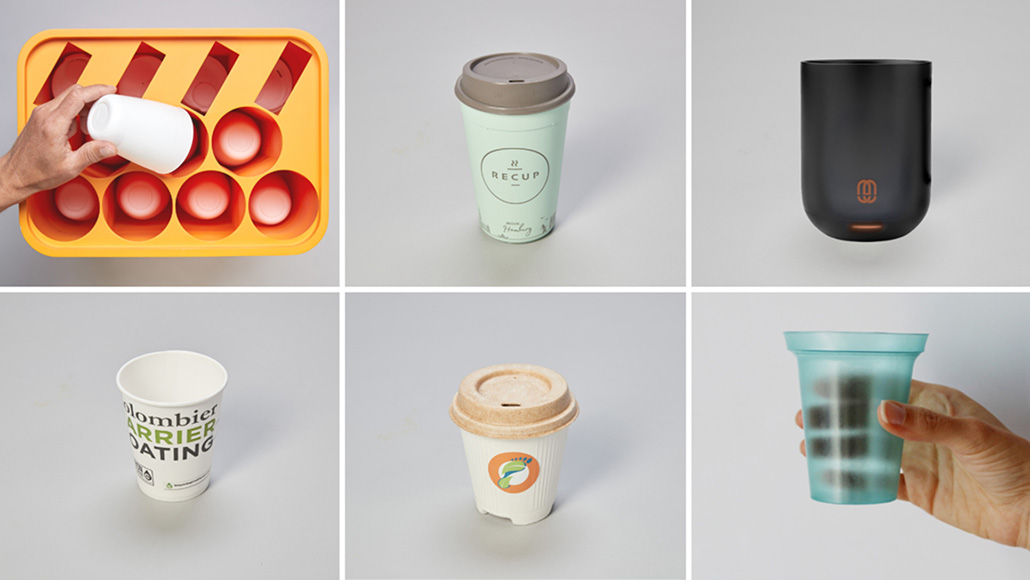
The NextGen Consortium, a pre-competitive collaboration managed by Closed Loop Partners in partnership with Starbucks and McDonald’s, accelerates towards a more circular cup system.
Contact: [email protected]
September 25 – NextGen Consortium Partners, investors, and other stakeholders convened during Climate Week in New York City for a Demo Day in which six participants in the NextGen Circular Business Accelerator showcased their manufacture-ready prototypes and pitch-ready business plans for growing their sustainable cup solutions.
The Accelerator follows Closed Loop Partners’ announcement of 12 NextGen Cup Challenge winners in February 2019. Six winning teams entered the NextGen Circular Business Accelerator, launched in partnership with global design firm IDEO to help companies further refine their cup solutions through rapid learning and iteration. The diverse solutions include cutting-edge plant-based materials, new innovative liners for cups, and reusable cup systems that redesign the fiber to-go cup so that it is more widely recoverable or remains in circulation for multiple uses. The six teams participating in the Accelerator are Colombier, CupClub, Footprint, Muuse, RECUP, and SoluBlue.
During the rigorous, six-month Accelerator program, companies accelerated their learnings through live in-context prototyping across four distinct Google campus locations, each housing multiple cafes. Progress for each cup solution was measured across four key categories: customer experience, server experience, performance, and disposal. Companies were able to see first-hand how customers and servers interact with their cups in a restaurant-like environment, capturing real-time feedback in a low-risk setting and identifying areas for refinement.
Companies also visited materials recovery facilities and explored the recovery side of the cup value chain, learning about the systems and infrastructure in place to ensure that their solutions are in alignment. Additionally, companies studied the value of materials recovered post-processing of their cups in order to make the economic case for more circular approaches.
Throughout the Accelerator, companies gained invaluable feedback through direct engagement with NextGen Consortium Partners, including founding partners Starbucks and McDonald’s, supporting partners The Coca-Cola Company, Yum! Brands, Nestlé, and Wendy’s, advisory partner WWF, and innovation partner IDEO. Feedback included insight into what it would take to roll out their solutions at a large scale.
“We are proud of the NextGen collaboration underway with so many companies championing greener cup technologies. We applaud Closed Loop Partners’ continued, on-track progress to determine what’s most viable, and we are excited for our own customers to try greener cups in our stores in the near future.”
John Kelly, senior vice president, Global Public Affairs & Social Impact at Starbucks
The companies were also welcomed behind the scenes of a McDonald’s restaurant to better understand how cups work within a store’s layout and staff operations.
“We were thrilled to have participants in the NextGen Circular Business Accelerator experience. Having these next gen solutions in our restaurants to see first-hand how our crew members manage through our restaurant operations is an important step. Compatibility with the fast pace of a QSR setting is critical, and it was great to see Accelerator teams jump at the opportunity to better understand these in-restaurant conditions. These cup solutions are helping shape the future of packaging, and we want to set them up for success while keeping valuable materials in circulation and, importantly, out of landfills and our oceans.”
Marion Gross, Senior Vice President and Chief Supply Chain Officer, McDonald’s USA
“Seeing how far participants in the NextGen Circular Business Accelerator have come is truly rewarding. The NextGen Consortium will continue to work with winning teams to ensure that when their solutions do enter market at scale they’re set up for success and recoverability.“
Kate Daly, Managing Director of the Center for the Circular Economy at Closed Loop Partners
The other six winners of the NextGen Cup Challenge, which are later-stage in their development, are working with the NextGen Consortium to identify in-market piloting opportunities in regions across the globe. Some participants in the NextGen Circular Business Accelerator are also expected to announce in-store pilots as early as 2020.
The Cup Challenge and the NextGen Circular Business Accelerator are just one part of the NextGen Consortium’s efforts to address single-use food packaging waste globally by advancing the design, commercialization, and recovery of food packaging alternatives. The Consortium is also focused on infrastructure and consumer engagement, supported by stakeholder collaboration across the value chain.
“Watching the aggregation of innovative ideas turn into real progress has been exciting to watch. Now we’ll look to the members of the NextGen Consortium to take these solutions into the marketplace and watch real change happen.”
Erin Simon, Director, Sustainability R&D, World Wildlife Fund
About NextGen
Each year, an estimated 250 billion fiber to-go cups are distributed worldwide. Most of these are not recyclable or compostable. The NextGen Consortium and Cup Challenge launched in 2018 to bring together entrepreneurs, industry, and recyclers to identify and commercialize the next generation of recyclable and/or compostable cups. Closed Loop Partners, Starbucks, McDonald’s, The Coca-Cola Company, Yum! Brands, Nestlé and Wendy’s invite the industry to join this effort to identify a global solution to this shared challenge.
About Closed Loop Partners
Closed Loop Partners is an investment firm that invests in sustainable consumer goods, recycling, and the development of the circular economy. Investors include many of the world’s largest consumer goods companies and family offices interested in investments that provide strong financial returns and tangible social impact. In 2018, Closed Loop Partners launched the Center for the Circular Economy, a New York City-based collaboration center for innovators to commercialize products, services, and technologies that are leading the transition from a linear take, make, waste economy to a restorative one in which materials are shared, re-used, and continuously cycled. Learn more at www.closedlooppartners.com.
About McDonald’s
McDonald’s is the world’s leading global foodservice retailer with over 37,000 locations in over 100 countries. Over 90 percent of McDonald’s restaurants worldwide are owned and operated by independent local business men and women. This year McDonald’s announced a series of commitments demonstrating how it will use its Scale for Good to positively impact the planet and the communities it serves. You can read more about McDonald’s Scale for Good initiatives here.
About Starbucks
Since 1971, Starbucks Coffee Company has been committed to ethically sourcing and roasting high-quality arabica coffee. Today, with stores around the globe, the company is the premier roaster and retailer of specialty coffee in the world. Through our unwavering commitment to excellence and our guiding principles, we bring the unique Starbucks Experience to life for every customer through every cup. To share in the experience, please visit us in our stores or online at http://news.starbucks.com or www.starbucks.com.
NextGen Consortium Partners
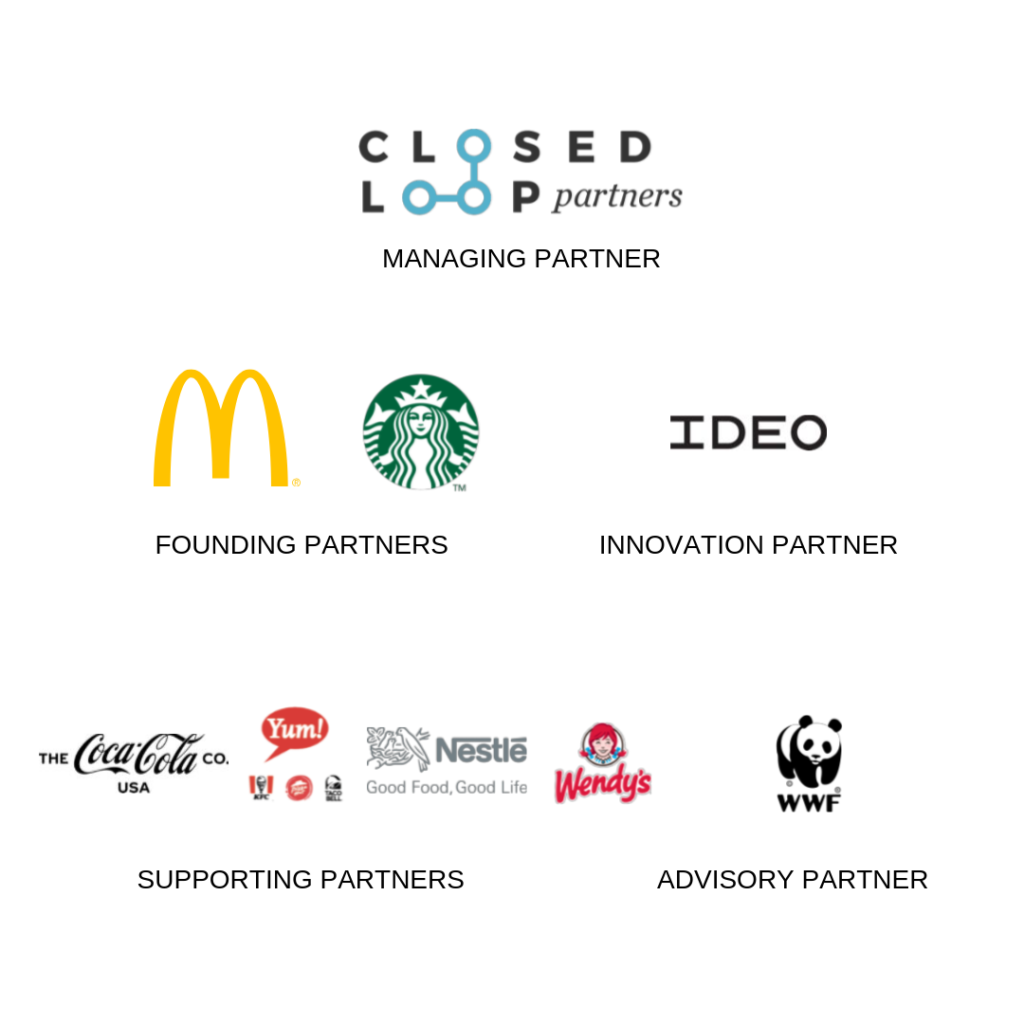
How to Use Design Thinking to Advance Systemic Change, One Cup at a Time
August 05, 2019
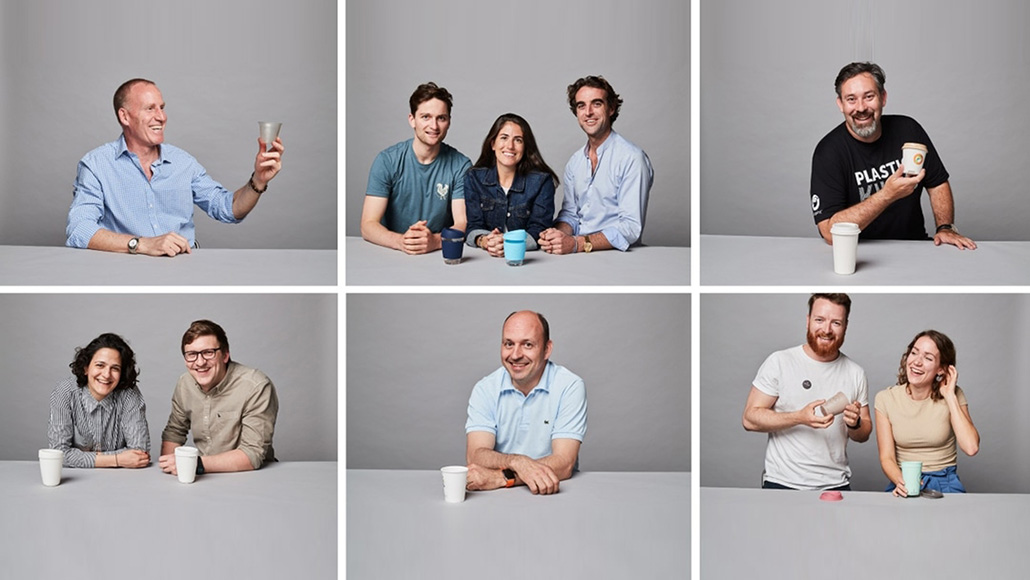
Amid burbling espresso machines and towering stacks of cups, six teams in the NextGen Circular Business Accelerator are taking waste-free cup solutions to the next level. Venturing back of house at restaurants and into the world of waste management, see how teams use five design thinking practices to advance solutions for a more circular future.
The NextGen Consortium is a global initiative convened by Closed Loop Partners’ Center for the Circular Economy. Starbucks and McDonald’s are founding partners of the Consortium, together with supporting partners The Coca-Cola Company, Yum! Brands, Nestlé and Wendy’s, as well as WWF as an advisory partner. OpenIDEO is the Consortium’s innovation partner.
If you’re looking for a systemic challenge in need of some new thinking, look no further than your morning cup of coffee. Worldwide, 250 billion to-go cups are produced each year, and there’s an increasing need for recoverable alternatives. Most fiber cups have a plastic liner to prevent leaks. The fiber and plastic are recyclable once separated, but limitations and inconsistencies in recycling infrastructure around the world mean that in most markets these materials aren’t easily recovered. The trouble is, as OpenIDEO Circular Program Lead Chris Krohn explains,
“When we have a systems design challenge, we can’t expect to solve it using the same approach that created the problem. It’s essential to understand the issue from perspectives across the entire value chain, and then work across that system to develop a holistic solution.”
In pursuit of some fresh ideas, Closed Loop Partners launched the NextGen Consortium: a multi-year partnership of food and beverage industry leaders that aims to address global single-use food packaging waste. Up first, the ubiquitous hot and cold, fiber-based, to-go cup. The NextGen Cup Challenge identified twelve innovators with the most promising cup solutions – from new cup liners to reusable cup systems. Of those, six winning teams (pictured above) joined the NextGen Circular Business Accelerator, an initiative to help prepare the teams for testing and scaling their solutions to meet the needs of today’s biggest brands and consumers worldwide.
Before rolling out new cup solutions in a real-world setting, it was essential for Accelerator teams to understand the customer needs, business realities, infrastructure challenges, and people at the core of the cup ecosystem. In a week-long design Bootcamp that took us behind counters and across the San Francisco Bay Area, OpenIDEO, with support from Closed Loop Partners, led teams through five design thinking practices to quickly surface new insights and inspiration. Try them out yourself the next time you’re working on a complex problem.
1. Center on a plan for informed, effective research
Design a fresh perspective. An essential part of the design thinking process is design research: exploring what people say, think, do and feel to help build human-centered solutions. This often means getting out into the field to meet people where they are, which helps us understand real needs and imagine what’s next. As Nina Montgomery, an IDEO design researcher, shared with NextGen Accelerator teams at the start of the Bootcamp,
“The power of design research is that—through empathy and inspiration—it is able to surface new thinking.”
Start with what you know. Before jumping into the field, it’s helpful to curate some background knowledge. We worked with each Accelerator team to compile insights from desk research—across internal documents, datasets, and market, competitor and business plan analysis—to get a sense of what was known and what we needed to test. Some teams, like RECUP from Munich, Germany, plan to roll out systems involving reusable cups, while others, like Solublue from London, UK, are building biodegradable cup solutions from new materials. Despite this diversity in business models, every team needed to know how consumers and distributors would respond to their particular cups. We also took into consideration the needs of Consortium Partners like McDonald’s and Starbucks to help identify any gaps and inform the key questions each team had to answer to set themselves up for scale.
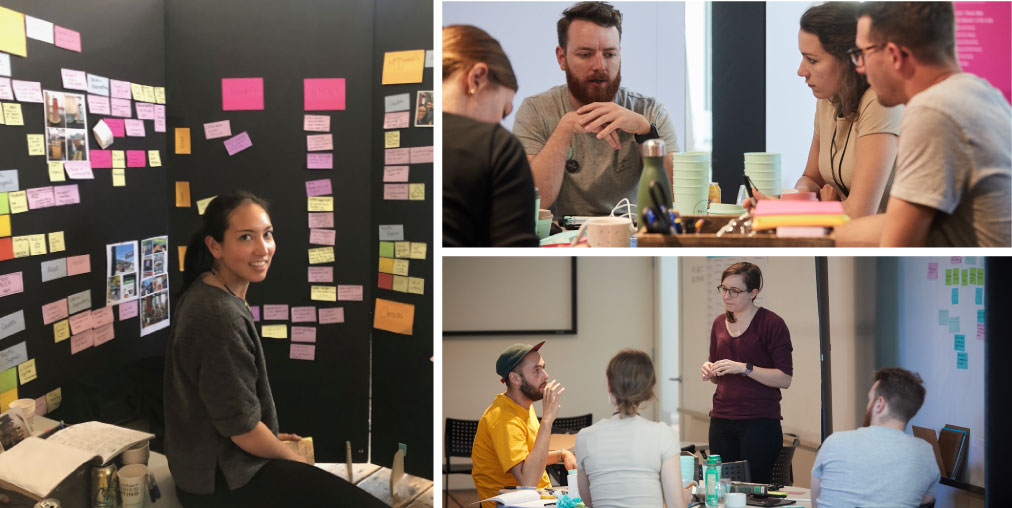
NextGen Circular Business Accelerator teams make a plan for their design field research.
Develop a research game plan. With this in mind, we kicked off the Bootcamp by developing a design research plan. This included deciding on research methods, team roles, and questions to ask in the field, and ensuring we were integrating research ethics. Building on background research, we helped Accelerator teams identify and schedule time to visit the kinds of people and places that would surface valuable, diverse insights about the to-go cup ecosystem. Together, we synthesized research questions in a discussion guide that was shared with each team member, ensuring that field research focused on what mattered most. Armed with a plan, a notebook, Sharpies, and lots of Post-Its, we were ready to hit the streets of San Francisco.
Try it:
- Explore a variety of design research methods in Design Kit.
- Focus in on your key research questions using this Design Research Discussion Guide.
2. Gain micro-level insights through observation
Watch and learn. That’s how, on a bright Tuesday morning, a group of IDEO designers and Accelerator entrepreneurs found ourselves attentively watching a stream of cups dance between hands and over counters at a San Francisco McDonald’s. Observation is a key method of design thinking. By taking a step back and looking carefully, we can better understand systems at a micro level.
At McDonald’s, observing employees interact with cups soon surfaced some fresh insights. To keep up with the lunch rush, cups must be easy to grab with one hand, nest well but also release easily from a stack, and communicate branding. Through observation, Accelerator teams quickly built empathy for the employees and identified how their new cups would or would not meet McDonald’s needs. By allowing us to observe their operations, McDonald’s was able to easily communicate their business realities and product requirements in a way that would have been impossible through words alone.
“Everyone knows McDonald’s, but how many people can say they’ve experienced the back of house logistics required to operate one? The Bootcamp provided opportunities like this that startups only dream about, and catapulted our growth potential in ways we’ll still be processing months later.”
Lizzie Horvitz, one of the Accelerator participants
Try it:
- Observation is simple. Grab a notebook, a pen, & scope out a good place to watch & listen.
- Find tips for getting started in this quick Design Research Field Guide from IDEO.
3. Uncover disconnects and trends with interviews and intercepts
Listen for gold. To fully understand what someone is thinking or feeling, we’ve found it’s often best just to ask. Building on our observations, we set up interviews with baristas, managers, and more, asking open-ended “how” and “why” questions that encouraged them to speak freely.
What we heard was a surprising amount of confusion around cup disposal best practices. In one coffee shop, baristas were told to compost cups, while the trash bins in the shop had signs instructing customers to recycle—both instructions contrasting with San Francisco waste management company Recology’s guidelines. User interviews helped teams identify pain points and systemic disconnects which would have been tough to spot without talking to the people on the ground.
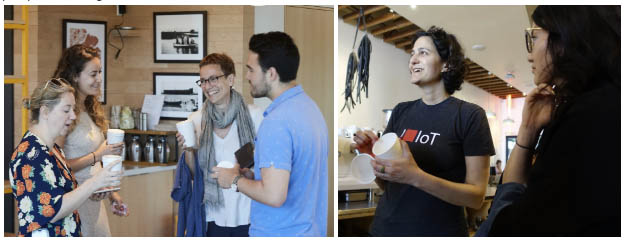
Teams gather user feedback on their cup designs and systems during intercepts and interviews.
Intercept for quick insights. The trouble with interviews: they can take time to set up. That’s why we also practiced intercepts— brief moments of connection with users that allowed us to capture impressions and test assumptions in real time. Conducting an intercept is as simple as walking up to a friendly face, introducing yourself, and asking a single important question.
The Footprint team—offering fully formed fiber-based cup solutions—tried out intercepts in a coffee shop, surveying customer opinions on their brown fiber cup vs. their more traditional white cup. The responses were intriguing. In general, millennials seemed to prefer the brown cup, describing it as “natural,” while older generations felt it looked “dirty.” By compiling responses, intercepts helped our teams quickly identify demographic trends and interests that would help define their future product offerings.
“Field research during the bootcamp showed us that there is potential to improve our cups and lids both for convenience and recyclability. We also got better insights into how logistics and incentives around the cup system might need to be adapted for the US market.”
Alexandra Gurstmeier of ReCup
Bring it all together. After every field research session, it’s important to debrief to ensure insights aren’t lost. With each Accelerator team, we’d synthesize—transferring notes from observations and interview guides onto post-its, sticking them up on a board, and grouping where we saw trends. This process helped the teams identify the essential flags, opportunities, and business considerations that surfaced in their research.
Try it:
- Use this Interview Guide to shape consumer conversations and ask strong questions.
- Fill out an Intercept Worksheet to get set up for these quick moments of connection.
4. See a challenge with fresh eyes through analogous experiences
Learn from others. Paradoxically, sometimes the best way to think differently is to seek what’s similar. Analogous research takes a look at different industries to find inspiration in the ways others have tackled similar challenges. During the Accelerator, we paired teams with organizations that have successfully worked through an issue our teams were currently facing. For example, the Solublue team—offering a plant-based, biodegradable cup solution—is currently preparing to ramp up its production. The team toured the Dandelion Chocolate factory for an inside look at how they set up and scaled their manufacturing process.
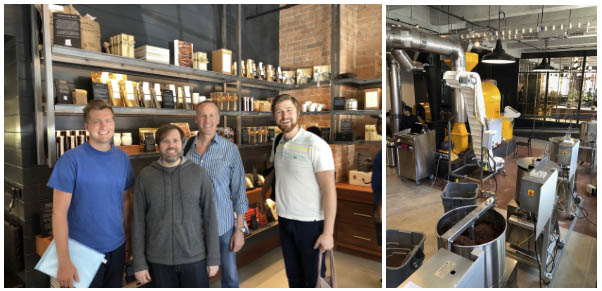
The Solublue team and IDEO design researchers explore the manufacturing systems of Dandelion Chocolate as analogous research.
Meanwhile, the CupClub team, which creates reusable cups people can pick up in a coffee shop and deposit at dedicated drop points around their city, found inspiration from an unusual source: rentable electric scooters. While cups and scooters may not seem to share much in common, CupClub learned from the Spin team how they managed the “economies” that popped up around their scooters, which provided quick cash for people willing to collect and recharge the scooters at home. This insight led to an interesting question for the CupClub team: how might we build economies of support around a reusable cup model that promote sustainability and job creation?
As the teams found, analogous research is a great way to gain a new perspective, learn from other’s struggles and successes, and help break through entrenched thinking.
Try it:
- Brainstorm: what other industries are tackling problems similar to the ones you are facing? What can you learn from their approach? Use this analogous inspiration exercise as a guide.
5. Map the existing infrastructure to define the path forward
Get real. To design sustainably, it’s essential to understand and integrate into the existing ecosystem that will touch a product over its lifecycle. Mapping how each team’s solution fit within the broader cup recovery infrastructure was crucial to ensure their cups would be fully recoverable down the line.
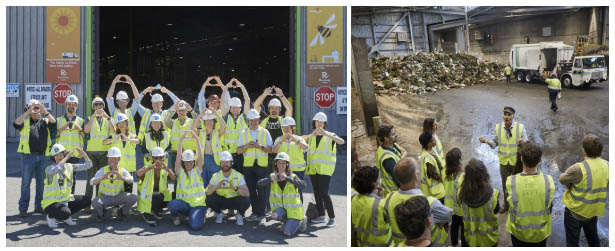
NextGen Circular Business Accelerator teams tour San Francisco’s waste recovery center, Recology.
Seek an informed perspective. Learning from experts, Accelerator teams toured waste management expert Recology’s facilities to better understand the technological capabilities and market forces affecting the local Bay Area recovery infrastructure. During the visit, teams had the opportunity to run their products through Recology’s recycling lines to gather real-time performance data. Teams also heard from Kate Daly, Managing Director at Closed Loop Partners, who shared a macro-perspective on global trends in recovery and reuse, and helped the teams think big picture—connecting upstream innovation to downstream recovery.
“Alignment between the design of cups and infrastructure is critical for capturing materials at every phase of a cup’s life cycle. It’s also important that as we continue to design for a better, more sustainable future, our infrastructure evolves too.”
Map the journey ahead. With these insights in mind, it was time to pull it all together. To get started, we helped teams consider their product journey, including all the people engaged along the way. The teams created a Post-It to represent every actor—from raw material producers and manufacturing technicians to corporate and distribution partners, consumers, and waste management experts—and made note of their specific needs as identified through research. Between actors, we drew lines to represent relationships: those that already existed, and those that each team needed to build in order to scale their solutions.
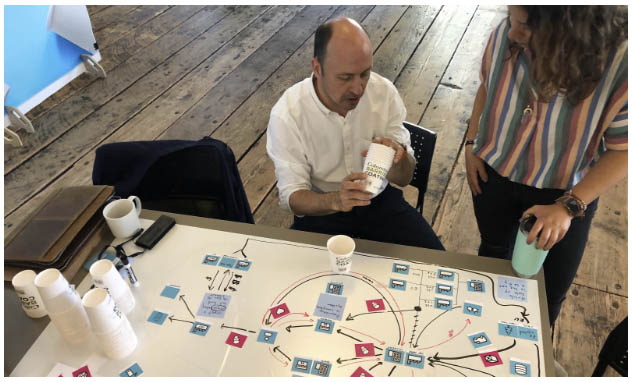
Ecosystem mapping with Henrik Björnberg, Chair of Colombier Group. Winning Cup Category: Innovative Cup Liner
The takeaways from the ecosystem mapping process set the Accelerator teams up with an actionable roll-out plan that identified their place within the existing infrastructure and who they needed to build partnerships with in pursuit of a fully circular, sustainable cup system.
Try it:
- Try out this product journey mapping exercise, then imagine new partnerships that could strengthen your network.
All together, these five design thinking practices helped our NextGen Accelerator teams gain a deeper understanding of the complex micro systems and macro infrastructure their products need to serve, while enabling Consortium Partners to quickly surface business realities and sticking points, helping to de-risk and accelerate the roll-out of new cups worldwide.
While not everyone can embark on a research sprint through futuristic waste recovery facilities and McDonald’s back-of-house experiences, anyone can apply design thinking practices to uncover fresh insights.
When addressing a problem that requires systemic change—prep, observe, interview, seek analogous inspiration, and map it out. The result could be some powerful new thinking, or perhaps even the holistic, circular cup of the future.
Sustainable Packaging Coalition and Center for the Circular Economy at Closed Loop Partners Announce Winner of the FlexPack Recovery Challenge
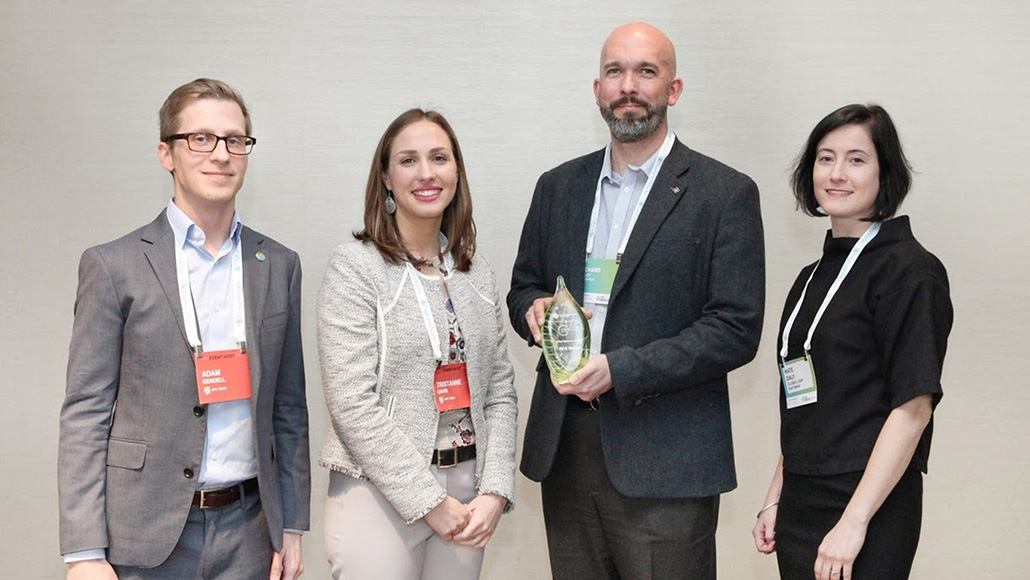
Start-ups from across the globe showcased their recovery technologies for a fast-growing category of hard-to-recycle flexible plastic packaging, and one winner was selected to join a mentorship program with the Sustainable Packaging Coalition & Closed Loop Partners.
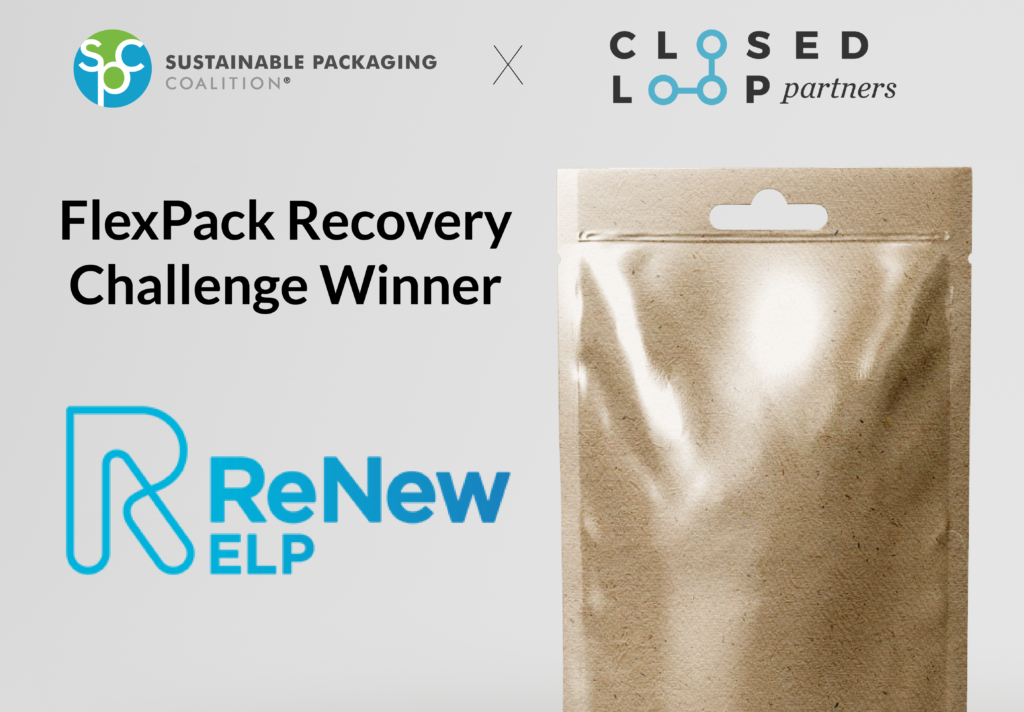
CHARLOTTESVILLE, VA and NEW YORK, NY — the Center for the Circular Economy at Closed Loop Partners and the Sustainable Packaging Coalition (SPC) have announced the winner of the FlexPack Recovery Challenge: ReNew ELP.
In October 2018, the SPC and the Center for the Circular Economy at Closed Loop Partners launched the FlexPack Recovery Challenge, an open competition for innovators, entrepreneurs, and start-ups to submit new ideas for reprocessing technologies capable of beneficially recovering multi-material flexible packaging waste.
Five finalists were selected by a panel of judges from the SPC and the Center for the Circular Economy at Closed Loop Partners staff, as well as with input from industry advisors. Each finalist participated in the SPC’s spring conference SPC Impact and presented to an audience of major brands, plastic manufacturers, and packaging suppliers, including members of the SPC’s Industry Leadership Committee on Multi-Material Flexible Recovery, on how their technologies can beneficially recover the embodied environmental investment within multi-material flexible packaging waste and can be scaled to provide meaningful solutions. These finalists included Cadel De-Inking, ReNewELP, Renewlogy, Synova-BioBTX, and Ekopolimer. Read more about all of our finalists.
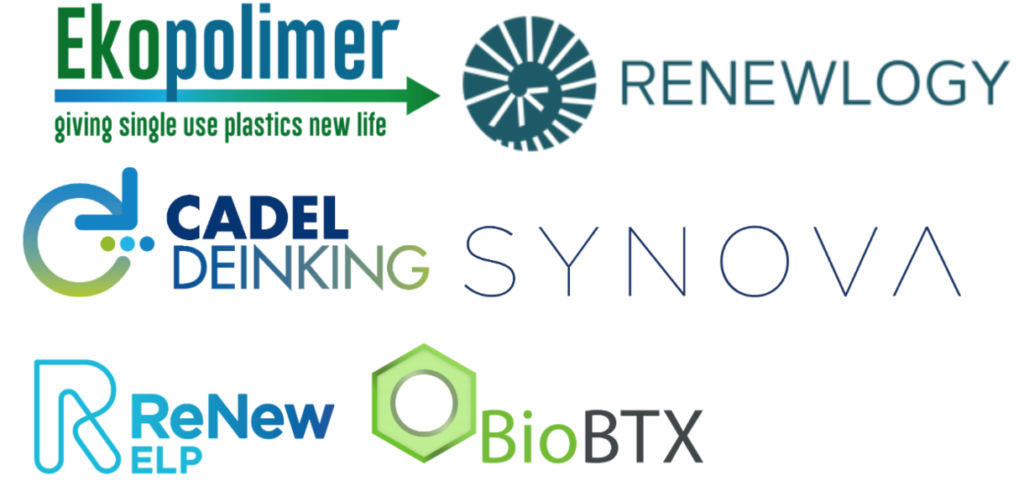
Among the five finalists, ReNewELP was selected as the final Challenge winner. RenewELP will receive a free year of membership to the SPC and enter into a mentorship program jointly run by the SPC and Closed Loop Partners.
“RenewELP submitted a detailed, transparent process description and market analysis. We were impressed with the processing capacity scale (up to 80,000 -100,000 tons per year in their initial facility) and the fact that their unique CAT-HTR technology allows for mixed waste feedstocks, including paper, PET and organics. Their modular approach considers variable material costs in different markets and their end markets for diverse hydrocarbon products like oils, waxes, and chemicals represent large market potential. RenewELP is a great fit to participate in a mentorship program run by our organizations,”
said representatives from the SPC and Closed Loop Partners in a joint statement.
The SPC & The Center for the Circular Economy at Closed Loop Partners team followed up with Richard Daley, Managing Director of RenewELP, for a post challenge interview.
Read the Q&A with Richard here
The SPC and CLP believe that all of technologies presented by the Finalists represent the kinds of diverse solutions needed for recovery of flexible packaging. We look forward to staying in touch with all the finalists and tracking and promoting their progress.
Learn more about the FlexPack Recovery Challenge.
ABOUT THE CENTER FOR THE CIRCULAR ECONOMY AT CLOSED LOOP PARTNERS
The Center for the Circular Economy brings together industry experts, academic researchers, and entrepreneurs who are solving for today’s most pressing challenges in design and reuse, providing a collaboration center for innovators to commercialize products, services and technologies that are leading the transition from a linear take, make, waste economy to a restorative one in which materials are shared, re-used, and continuously cycled.
ABOUT THE SUSTAINABLE PACKAGING COALITION
The Sustainable Packaging Coalition is a membership-based collaborative led by an independent non-profit that believes in the power of industry to make packaging more sustainable. Using an objective life-cycle-based approach, we work in a constructive atmosphere to provide thought leadership and bring our members together to strengthen and advocate the business case for more sustainable packaging.
